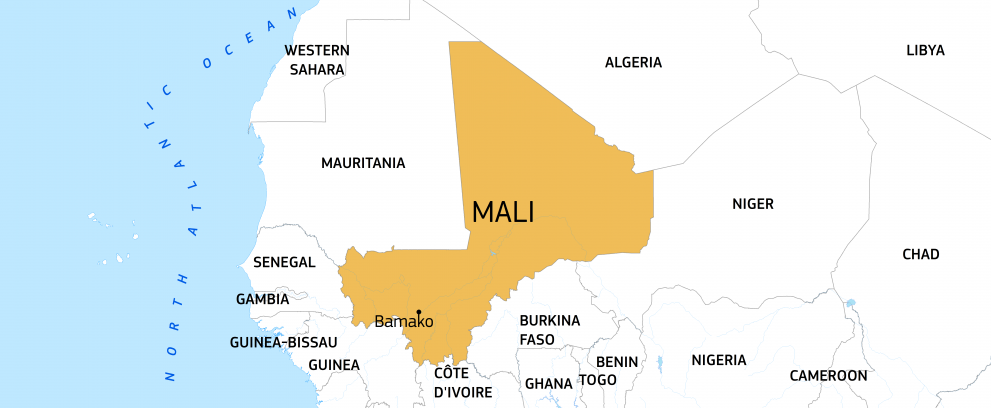Introduction
7.1 million people, corresponding to 1/3 of Mali’s population, need urgent humanitarian assistance, with catastrophic hunger predicted in the conflict-affected North and Centre regions of the country.
Mali’s complex crisis is marked by insecurity resulting in population displacements and people stranded in conflict-affected or in blockaded areas, as well as instability, socio-political climate shocks and epidemics.
Violations of human rights and international humanitarian law are increasingly prevalent. As a leading donor, the EU continues its efforts to reach the most vulnerable Malians in need in the hardest-to-reach areas with humanitarian aid.
What are the needs?
The political, economic and security situation in Mali which is under military rule since August 2020 is expected to continue deteriorating throughout 2024.
In addition to conflict, the economic downturn, characterised by rising inflation, stagnant production, and trade barriers, is causing food shortages, and impacting people’s livelihoods.
7.1 million people are in need. More than 1.3 million people including more than 330,000 internally displaced and almost 850,000 returnees are of concern. Over 180,000 Burkinabe refugees are also taking shelter in Mali.
In 2024, almost 1.4 million people require urgent food assistance during the lean season between harvests. 3.3 million people, including 2.5 million under-fives, need nutrition care. With 1 out of 4 health facilities in the North and Centre not functioning due to insecurity and lack of staff and supplies, an estimated 3.5 million people need help to access health care.
Pockets of famine are for the first time in years predicted up North. High levels of acute malnutrition are reported, especially among displaced people in northern and central Mali and those cut off from aid in areas under blockade.
The violence also affects the education system: 1 791 schools are closed, leaving over 588,000 children out of school.
Since 2012, conflict in Mali has affected millions of civilians with a steady increase in violence since 2018 and severe violations of international humanitarian law. 1.6 million people require protection assistance in 2024.

How are we helping?
The EU is a leading donor of assistance to people in need in Mali. It has provided more than €506 million in humanitarian aid in-country since 2012, and an allocation of €34.7 million in 2024. Last year, EU humanitarian aid amounted to €36 million at the end of 2023.
EU humanitarian aid in Mali addresses the most urgent needs of displaced and vulnerable populations in conflict-affected and fragile areas. In response to the increasing humanitarian needs and the access constraints, EU humanitarian aid focuses both on internally displaced persons and on people trapped in conflict zones with limited supplies and social services. The EU considers the protection of civilians as a central focus of our needs-based and conflict-sensitive response.
Our assistance covers overall (i) food assistance, (ii) essential household items and emergency shelter, (iii) health and nutrition care, (iv) protection and psychosocial support, (v) education for children, and (vi) humanitarian coordination and the transportation of humanitarian workers and supplies to remote and inaccessible locations.
The EU-supported rapid response mechanism aimed at supporting newly displaced people, provides food assistance, basic shelter, restores access to drinking water, and essential household items to newly displaced persons. This response is also complemented by rapid responses in health, protection, and education.
Emergency food aid is also being provided to populations facing severe food insecurity during the lean season. Our partners also provide health and nutrition care to the most vulnerable in areas where these services are not functioning or are inaccessible, delivering essential care and medicines. Moreover, every year, the EU contributes to treating severe acute malnutrition across the country. We fund the purchase and supply of therapeutic food and essential medicines for children suffering from this type of undernourishment.
The EU also helps to overcome the obstacles of a challenging operational environment by supporting the coordination of humanitarian actors, security analysis, logistics and aviation services. To access hard-to-reach areas in Mali’s northern and central parts, the EU operates a humanitarian air service, transporting humanitarian workers and relief assistance for people in need. In complementarity with this service, the EU contributes to the UN’s Humanitarian Air Service (UNHAS).
Other EU-funded organisations provide protection and education to displaced and out-of-school children. Where and when possible, assistance is delivered through cash transfers and vouchers to enable people to buy what their households require the most.
We aim to ensure coordination between actions addressing immediate humanitarian needs and projects that tackle the root causes of crises. Efforts are ongoing for ensuring that humanitarian and development aid can complement each other in Mali in a context of increasing constraints and complexification of the crisis. With EU aid, people in need build resilience to recurrent crises with time, making them less vulnerable in the future.
Last updated: 20/09/2024
Facts & figures
8th highest child mortality rate in the world (World Bank)
7.1 million people need humanitarian aid
More than 1.37 million people requiring emergency food assistance between June-August 2024
313,000 children under 5 severely malnourished
(Cadre Harmonisé, March 2024)
330,700 internally displaced
Over 95,000 refugees
935,000 returned refugees or displaced people
(UNHCR, 31 May 2024)
EU humanitarian funding:
€34.7 million in 2024
€36 million in 2023
More than €506 million since 2012

